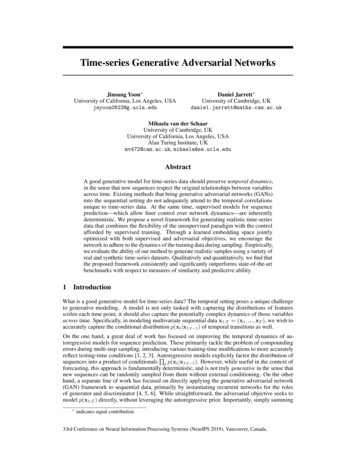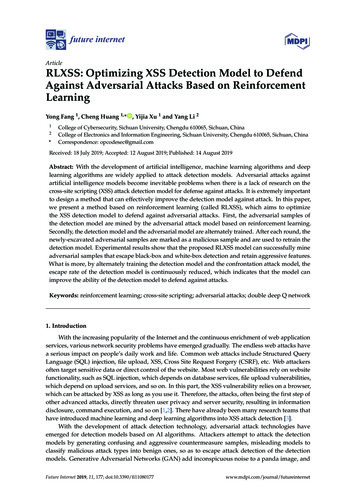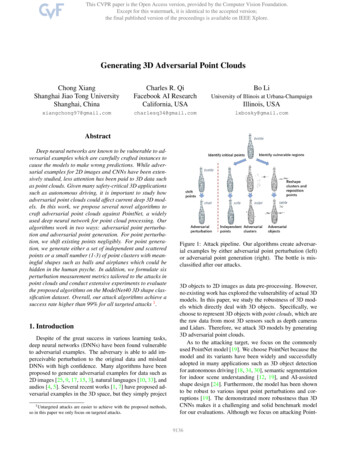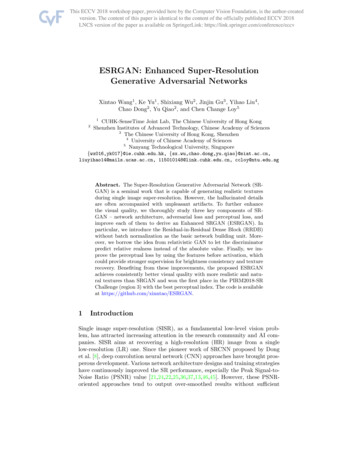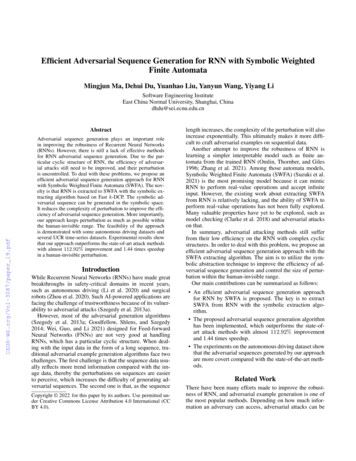
Transcription
Efficient Adversarial Sequence Generation for RNN with Symbolic WeightedFinite AutomataMingjun Ma, Dehui Du, Yuanhao Liu, Yanyun Wang, Yiyang LiSoftware Engineering InstituteEast China Normal University, Shanghai, Chinadhdu@sei.ecnu.edu.cnAbstractAdversarial sequence generation plays an important rolein improving the robustness of Recurrent Neural Networks(RNNs). However, there is still a lack of effective methodsfor RNN adversarial sequence generation. Due to the particular cyclic structure of RNN, the efficiency of adversarial attacks still need to be improved, and their perturbationis uncontrolled. To deal with these problems, we propose anefficient adversarial sequence generation approach for RNNwith Symbolic Weighted Finite Automata (SWFA). The novelty is that RNN is extracted to SWFA with the symbolic extracting algorithm based on Fast k-DCP. The symbolic adversarial sequence can be generated in the symbolic space.It reduces the complexity of perturbation to improve the efficiency of adversarial sequence generation. More importantly,our approach keeps perturbation as much as possible withinthe human-invisible range. The feasibility of the approachis demonstrated with some autonomous driving datasets andseveral UCR time-series datasets. Experimental results showthat our approach outperforms the state-of-art attack methodswith almost 112.92% improvement and 1.44 times speedupin a human-invisible perturbation.IntroductionWhile Recurrent Neural Networks (RNNs) have made greatbreakthroughs in safety-critical domains in recent years,such as autonomous driving (Li et al. 2020) and surgicalrobots (Zhou et al. 2020). Such AI-powered applications arefacing the challenge of trustworthiness because of its vulnerability to adversarial attacks (Szegedy et al. 2013a).However, most of the adversarial generation algorithms(Szegedy et al. 2013a; Goodfellow, Shlens, and Szegedy2014; Wei, Guo, and Li 2021) designed for Feed-forwardNeural Networks (FNNs) are not very good at handlingRNNs, which has a particular cyclic structure. When dealing with the input data in the form of a long sequence, traditional adversarial example generation algorithms face twochallenges. The first challenge is that the sequence data usually reflects more trend information compared with the image data, thereby the perturbations on sequences are easierto perceive, which increases the difficulty of generating adversarial sequences. The second one is that, as the sequenceCopyright 2022 for this paper by its authors. Use permitted under Creative Commons License Attribution 4.0 International (CCBY 4.0).length increases, the complexity of the perturbation will alsoincrease exponentially. This ultimately makes it more difficult to craft adversarial examples on sequential data.Another attempt to improve the robustness of RNN islearning a simpler interpretable model such as finite automata from the trained RNN (Omlin, Thornber, and Giles1996; Zhang et al. 2021). Among those automata models,Symbolic Weighted Finite Automata (SWFA) (Suzuki et al.2021) is the most promising model because it can mimicRNN to perform real-value operations and accept infiniteinput. However, the existing work about extracting SWFAfrom RNN is relatively lacking, and the ability of SWFA toperform real-value operations has not been fully explored.Many valuable properties have yet to be explored, such asmodel checking (Clarke et al. 2018) and adversarial attackson that.In summary, adversarial attacking methods still sufferfrom their low efficiency on the RNN with complex cyclicstructures. In order to deal with this problem, we propose anefficient adversarial sequence generation approach with theSWFA extracting algorithm. The aim is to utilize the symbolic abstraction technique to improve the efficiency of adversarial sequence generation and control the size of perturbation within the human-invisible range.Our main contributions can be summarized as follows: An efficient adversarial sequence generation approachfor RNN by SWFA is proposed. The key is to extractSWFA from RNN with the symbolic extraction algorithm. The proposed adversarial sequence generation algorithmhas been implemented, which outperforms the state-ofart attack methods with almost 112.92% improvementand 1.44 times speedup. The experiments on the autonomous driving dataset showthat the adversarial sequences generated by our approachare more covert compared with the state-of-the-art methods.Related WorkThere have been many efforts made to improve the robustness of RNN, and adversarial example generation is one ofthe most popular methods. Depending on how much information an adversary can access, adversarial attacks can be
classified into two categories: white-box attack (Szegedyet al. 2013b; Goodfellow, Shlens, and Szegedy 2015) andblack-box attack (Kurakin, Goodfellow, and Bengio 2016;Chen et al. 2017). As for whether the adversarial attack algorithms applied in the FNN are effective on RNN, it has beendiscussed in (Kurakin, Goodfellow, and Bengio 2016). However, the research on adversarial example generation optimized for RNN is rare, which is still a challenging problem.Besides, the extracting abstract models from RNN hasattracted more attention recently. Most are focused on extracting Label Transaction System (LTS) (Gorrieri 2017),such as DFA (Omlin, Thornber, and Giles 1996), WFA (Ayache, Eyraud, and Goudian 2018; Weiss, Goldberg, and Yahav 2018; Zhang et al. 2021), DTMC (Du et al. 2019), andPFA (Dong et al. 2019). But the existing work aims at outputting boolean values, which is not suitable for the realworld RNN applications. This challenge motivates the extraction of the quantitative finite state machine as an abstraction of RNN. WFA is a powerful abstract model for RNNbecause it outputs the real value. For WFA extraction work,there are spectral techniques (Ayache, Eyraud, and Goudian2018), L* query learning algorithm (Weiss, Goldberg, andYahav 2018), and Decision-guide approach (Du et al. 2019).This work (Suzuki et al. 2021) proposes the query learning algorithm for Symbolic Weighted Finite Automata(SWFA). As an extension of WFA, SWFA can handle stringsover infinite alphabets more efficiently, which generalizesWFAs by allowing transitions to be functions from a possibly infinite alphabet to weights. Inspired by their work, wepropose Fast k-DCP to extract SWFA from RNN, which canbe utilized to improve the efficiency of adversarial sequencegeneration.PreliminariesThis section briefly introduces some necessary preliminaries and notations to understand our approach. Specially, wesummarize the essence of the adversarial sequence generation approach and the symbolic abstracting technology.for classification tasks, g is specified as a softmax function.f and g are shared between different time steps t in an RNN.As for the input data, we define the dataset with n samplesas D {(xi , li ) i 1, 2, . . . , n}, where x X is an inputsample and l is the true label of the sample. For classificationtasks, l is in a finite set L containing all possible labels. Asingle sample x X with m-sequence is in the form like avector x [x(1) , x(2) , . . . , x(i) , . . . , x(m) ], which includesthe input at different time steps. x(i) is the input value at thei-th time step on sample x. Input space matrix X Rn m ,where n denotes the number of samples and m indicates thesequence length. The matrix Y Rn L is used to store thefinal output, which is the possibility of each label for eachsample in an RNN classification task.Symbolic Weighted Finite AutomataA Symbolic Weighted Finite Automata (SWFA) Υ over Gcan be formulated as a tuple (Suzuki et al. 2021).Definition 2 (Symbolic Weighted Finite Automata)SWFA is denoted as a 5-tuple Υ (G, Q, α, β, A), the setof all functions from X to Y is denoted by Y X .where G is a class of guard functions from an alphabet Σ to asemiring S. Q denotes the finite set of states. α is a vector of the initial weights SQ . β is a vector of the final weights SQ . A denotes a transition relation GQ Q , Aσ represents the transition relation for σ Σ, Aσ [q, q ′ ] A [q, q ′ ] (σ) for all (q, q ′ ) Q2 . Aσ can be extendedfor strings w Σ as Aw Aσ1 Aσ2 . . . Aσl , wherew σ1 σ2 . . . σl , with σi Σ. The formal power seriesfΥ represented by Υ is defined by fΥ (w) αT Aw β forall w Σ .Recurrent Neural NetworkRecurrent Neural Network is denoted as a recursive function h(t) (⃗x) f (h(t 1) (⃗x), ⃗x(t 1) ), representing the statetransitions during the learning process. h(t) (⃗x) Rn is thehidden state at time t, which is calculated by the input attime t and the hidden state at time t 1 together. RNN canalso be formulated as a tuple (Michalenko et al. 2019).Definition 1 (Recurrent Neural Network) RNN is denoted as a 6-tuple R (H, X, Y, h0 , f, g), where H denotes the set of hidden states.X is the possible input space.Y is the final output of RNN.h0 is the initial hidden state.f : H X H denotes the transition function.g : H Y denotes the output function.Note: During the entire RNN operation, f is called repeatedly, and g is called only once for the last output. AndFigure 1: SWFA with Q {q1 , q2 } and Σ { 1, 0, 1}SWFA can deal with a possibly infinite alphabet efficiently taking advantage of the structure of the alphabet.The minimization and equivalence checking for SWFAs canbe achieved.
Example 1 Let Σ { 1, 0, 1} , Q {q1 , q2 }, αT 2 12.0x2.,β [1 0], A 1 02.0x 1.0 xIf the input is x [1, 1], the result is obtained by multiplying a series of matrices as follows.αT · A 1 · A1 · β [5 3] .And such an SWFA can also be presented in a graphicalview, as shown in Fig.1. Each circle represents a state q, thelabel on each edge from q to q ′ is the assigned guard functionfrom Σ to Q, which represents its symbolic nature.As we can see, the symbolic representation of the weighton transitions enhances the abstraction ability of WFA. It isvery suitable to model the infinite alphabet of RNN’s input.Symbolic Weighted Finite Automata Extraction. The extracting algorithm extracts SWFA from the trained RNN. Itis the key part of the approach, which constructs the symbolic state space. On the other hand, the symbolic input areabstracted from datasets.Adversarial Sequences Generation by SWFA. We perturbthe symbolic input to get symbolic sequences. To acceleratethe generation process, we formally analyze the reachability of SWFA to rapidly check whether the newly generatedsymbolic sequence is an adversarial one. If the symbolic sequence is judged as an adversarial symbolic sequence, wecan collect concrete adversarial sequences from symbolicadversarial sequences by sampling techniques.Adversarial Example GenerationAdversarial example generation is a technology that uses adversarial attack methods to generate adversarial examples.An adversarial example refers to a sample formed by artificially adding subtle perturbations that are invisible to thenaked eyes. Such samples will cause the trained model tomisclassify the output (Huang et al. 2020). An adversarialexample can be denoted as:arg min Hi (x′ ) arg min Hi (x)iiFigure 2: The Overall Framework of Our approach x x′ p d arg max fj (x′ ) ̸ arg max fj (x)jjs.t. p 1, p N, d 0.H stands for the human inception, and f denotes the deepneural network’s judgment. Within the subtle perturbationd, the model makes the wrong classification. An adversarialexample has two characteristics, one is that the perturbationis so small that humans cannot notice it easily. The other isthat the classification result may be wrong.Researchers (Szegedy et al. 2013a) have formulated thesearch for adversarial examples as an optimization problemto find the minimum ϵ, and used box-constraint L-BFGS toconduct attacks.arg min f (x ϵ) l, s.t. (x ϵ) DϵThe input x ϵ is in the same domain D with x, but getsa different label, which is an adversarial example. Thoughthe above optimization solution has a good performance,it is computationally cost. Then an efficient adversarial attack algorithm was introduced (Goodfellow, Shlens, andSzegedy 2014). It is named as Fast Gradient Sign Methodology (FSGM) which utilizes the gradient of the cost functionto generate the adversarial examples.Besides L-BFGS and FGSM, most of the adversarial attack methods are extended based on iterative methods togenerate adversarial examples efficiently.Main ApproachIn this section, we present the details of our adversarial sequence generation approach. Fig. 2 shows the overall framework. There are two phases in our approach.Symbolic Weighted Finite Automata ExtractionDefinition 3 (Fast k-DCP) Fast k-DCP is adapted fromk-DCP (Du et al. 2019), which is used for SWFA extractionfrom RNNs. k-DCP of a probability vector captures the topk ranked class labels as well as their prediction confidencelevels. Compared with k-DCP, Fast k-DCP has the followingnew features: High Efficiency: Different from k-DCP, Fast k-DCP discards the time-consuming k-means clustering processand divides hidden states of RNN into different symbolicblocks directly. Symbolic Abstraction: We extend Fast k-DCP for the infinite alphabet, which deals with input symbolically.The cost of symbolic abstraction will increase as the complexity of the learning task increases. It is not cost-effectiveto generate a small batch of adversarial examples when thetask is complex; it has advantages in a scenario where thetask complexity is lower and a large number of adversarialexamples need to be generated. Assuming that the numberof samples is n, the sequence length is m, the feature dimension is s, and the time complexity of symbolic abstraction can be denoted as O(mns), as the complexity of thetask increases, which means that n, m, or s becomes larger,the time cost of symbolic abstraction will also increase. Thespace complexity of symbolic abstraction is O(T s ). As thefeature dimension s increases, the space consumption willalso grow. But when the complexity of RNN increases, itsabstraction cost will not increase accordingly. The abstraction cost is only related to the scale of the task. Therefore,
Algorithm 1: RNN-SWFA by Fast k-DCPinput : RNN R (H, X, Y, h0 , f, g)Input sequences WK, Toutput: SWFA Υ (G, Q, α, β, ize Q′ [s0 ], Σ′ [ ], Q [ ], Σ [ ];Initialize A [ ], α πq0 , β [ ];d ComputeDistance (W );Tinput ⌈10/(d)/( W w )⌉;for w W do w s [h(i) (w)]i 0 ;for i 1 to w doQ′ .add(si );Σ′ .add(wi 1 )for q ′ Q′ doQ.add(f kdcpK,T (q ′ ));for σ ′ Σ′ do′Σ.add(f kdcp σ ,Tinput (σ ′ ));for σ Σ doAσ BuildT ransitionM atrix(σ);A.add(Aσ );for q Q doβq 0 with length L ;for q ′ Q′ doif f kdcpK,T (q ′ ) q thenβq [argmax(g(q ′ ))] 1;Pβq βq / (βq );β.add(βq );G GuardF untionLearning(Q, α, β, A);return SWFA Υ (G, Q, α, β, A)building SWFA has a comparative advantage in such a scenario.The proposed algorithm for extracting SWFA from RNNusing Fast k-DCP is elaborated in Alg 1. It takes the targetRNN R, the input sequences W which is a set of word w,the hyper-parameters K and T as inputs, and generates theextracted SWFA.To get the symbolic input, we calculate Tinput (Line 3 toLine 4), and then use Fast k-DCP to abstract the input (Line12 to Line 13) into symbolic blocks. Another purpose of calculating Tinput is to control the perturbation in a range thatis invisible to the human eye. It is a covert adversarial example. And we strongly recommend that computeDistanceuses the Euclidean distance L2 as the distance metric sincethe ideal task for our approach to show the advantage of efficiency is the one whose dimension of input data is relativelynot too high, at which Euclidean distance has been found tocapture proximity more accurately (Gopinath et al. 2017).We execute R on the input sequences W and record thehidden state traces as s (line 5 to Line 9). By this way, wecollect the step-wise configurations in a set of hidden statesQ′ , as well as the alphabet Σ′ .By applying Fast k-DCP f kdcp twice (Line 10 to Line13), we construct the set of abstract states Q and the symbolic alphabet Σ of SWFA. The symbolic alphabet is abstracted from the complete input, that is, the parameter K off kdcp here is set to the dimension of the input σ ′ .For each symbolic input σ in Σ (Line 14 to Line 16), weuse BuildT ransitionM atrix to count transition frequencyamong abstract states and then build the transition matrix Aσfor σ. All the matrices are collected into A.At last (Line 17 to Line 23), the initial distributionover the abstract states would be set to the one-point format, that is, the initial state α of SWFA. And we buildthe final vector β by calculating βq for each state. AndGuardF untionLearning learns the G from Q, α, β, A(Suzuki et al. 2021). In short, extracting SWFA from RNNis the main novelty of our approach. It utilizes the symbolicstate models to imitate the learning process of RNN. It helpsto generate the adversarial sequence effectively.Adversarial Sequence GenerationIn order to generate adversarial sequences efficiently, wetake full advantage of SWFA’s symbolic feature to perturbits symbolic input. It reduces the complexity of perturbation. Another novelty of our approach is to abstract the inputsequence with the symbolic technique. It is another organizational scheme that abstracts original input into severalsymbolic blocks.Definition 4 (Symbolic Block) Symbolic Block is denotedas a 3-tuple Bsymbolic (X, K, T ), where The parameter X means the input sequences. K denotes the dimension of the symbolic block. (Usually,K is less than 5) The parameter T denotes the granularity of the symbolicblock.The input is abstracted into several regions by Fast kDCP, and the regions can be composed of rectangles, cubes,or hypercubes according to K. Thus these equally dividedregions containing multiple real values are called as Symbolic Blocks. It’s used to abstract the input space.Example 2 Assuming the input is normalized into an interval [0,1], we equally divide the input into T parts. Asshown in Fig. 3, there are 3 3 3 symbolic blocks whereK 3 and T 3. Each symbolic block is like a small cube,and several symbolic blocks construct a vector space with atotal length of 1. Since the length of the vector is fixed, theprocess of abstracting input into symbolic input is very efficient and not time-consuming. We can quickly find anothersimilar input given a particular input based on the symbolicblock.We take Manhattan distance (L1 ) as the abstract distancemetric to measure the distance of the symbolic input, whichis shown as the following equation. x denotes the symbolicinput.nX′′ x x 1 x i x i (1)i 1
Algorithm 2:Adversarial Sequence Generation by SWFAinput : Input x0 ;Continuous c {true, f alse};Number of nodes to be disturbed n;Perturbation intensity ϵ {1, 2, 3}.output: Adversarial Sequence x′ . ′ ′1 Initialize x0 f kdcp(x0 ); x []; δ 0;23Figure 3: Abstract input space is divided into 3 3 3 Symbolic Blocks with T 3, K 3456The metric value is assumed as an integer when expressing the distance of the symbolic input for the convenienceof the later perturbation and guiding the value of T . ThoughL1 and L meet this requirement, L is not suitable due toits poor experimental results, so we choose L1 for the symbolic distance measurement. With the help of the distancemetric of the symbolic input, we can reduce the complexityof perturbation.The difference between the abstract perturbation and theconcrete perturbation is shown below. x′ x 2 ϵ(2)′ x x 1 ϵ (3)Equation (2) means that under the L2 (Manhattan distance) metric, the distance between the disturbed sample andthe original sample is denoted as ϵ. Equations (3) describesthe distance between the symbolic input x . Its perturbed′value x , measured by L1 , and ϵ denotes the abstract perturbation. Since we have δ T1 (Datamax Datamin ), andthe input is normalized in the early stage. We get Dmax 1,Dmin 0, so the relationship between the abstract perturbation and the concrete perturbation can be denoted asδ 1/T , which is also the unit of abstract perturbation.Configuration of Tinput It is very important to set an appropriate Tinput to get the symbolic input, which determinesthe granularity of symbolic blocks and controls the abstractperturbation within the human-invisible range as expected.The value of Tinput should satisfy the following property.Pn xi xi 1 1 i 2(4)δ Tinputn 1n 1i 2 xi xi 1 Tinput Pn(5)Perturbation and Instantiation In this part, we will iteratively increase ϵ to search for symbolic adversarialsequence and instantiate them to concrete adversarial sequences by sampling techniques, such as random sampling.Based on the concept of Symbolic Block and Abstract Distance Metric, we can perturb the sequences (as shown inFig. 4)in an efficient way. The main idea is shown in Alg.2.The first step as shown (Alg.2, line 3) is to find the nodesthat have the greatest impact on the sequence classification78while δ ϵ doN odes N odesSearch(c, n);for node N odes do′dir F indDirectionbyImportance(x 0 );′xpert P ert(x 0 , node, dir, δ);if verif yBySW F A(xpert ) then′x .add(xpert );δ δ 1;91011′′x Sampling(x );return x′results. By exploring several experiments, we find an interesting phenomenon that we call it as SWFA’s 000-status.Definition 5 (000-status)tor ζ, where000-status is denoted as a vec- ζ is a vector of SWFA’s intermediate weights SQ . Each of the components of the vector ζ is 0.It represents that the intermediate status of SWFA is like[0, 0, ., 0] and the input exceeds the generalization limit ofour model. A lot of experimental results show that sampleswith 000-status are more fragile and more likely to be adversarial sequences. The interesting results inspire us to useSWFA to calculate the intermediate status of the entire sequence at each point. And we record the 000-status point asthe perturbation point.The second step is to find the appropriate perturbation diirection by the least importance denoted by Pimportance iS /(m n), where superscript i represents the index of theblock and S means the number of sequences that fall intothe block. We use the insight above, if 000-status appearsin a certain perturbation direction in the SWFA computationresult, then these directions should be traversed.In the third step, the value of ϵ is iteratively increased toconduct the abstract perturbation. The size of ϵ representsthe intensity of the perturbation. We also provide the parameter c to control whether the perturbation is continuous.Symbolic Adversarial Sequence Generation by Reachability Analysis of SWFA We adopt Linear TemporalLogic (LTL) (Kesten, Pnueli, and Raviv 1998) to define symbolic adversarial sequence on SWFA, which is shown below:γ Z(6)where γ denotes the intermediate state of SWFA, denotes”satisfies”, and denotes ”eventually”, Z denotes 000-
to generate the Autonomous Driving Datasets (ADD) withthe sample size of 30,000. There are three classes of vehiclebehavior, turning left, going straight, turning right, denotedas label y. It contains several features. Detailed descriptionsof these datasets can be found in the Appendix.We train a 2-hidden-layer LSTM for our experiment, andthe number of hidden layer nodes is set to 1/200 of thedatasets’ size. The loss function is chosen as CrossEntropyLoss, and Adam is our choice for the optimizer. More detailed parameter settings of LSTM can also be found in theAppendix.Figure 4: Abstract perturbation on symbolic blocksstatus. If γ eventually meets 000-status, it means that it isa symbolic adversarial sequence.Finally, we use SWFA to rapidly check whether the abstract perturbated sample xpert is an adversarial sequence.′If verifyBySWFA returns true, we add it to x , the list ofsymbolic adversarial sequences. We then use sampling tech′niques to instantiate symbolic adversarial sequences x intothe set of concrete adversarial sequences x′ . we assume thatsymbolic adversarial sequences generated by our approachare largely successful, so it is feasible to use arbitrary sampling methods, and we use random sampling here.The novelty of our approach is that we conduct abstractperturbations on the symbolic space. It has two advantages.One is that the abstract perturbation has fewer possible iteration space, and the other is that we can generate concreteadversarial sequences from symbolic adversarial sequencesin the batch, which brings more efficiency.Experimental EvaluationTo demonstrate the effectiveness and efficiency of our approach, we conduct two experiments on well-trained LSTMfrom time-series data. The first is the implementation ofthe RNN-SWFA extraction algorithm using Fast k-DCP.The second is the implementation of SWFA-based adversarial sequence generation named AbASG. We compare itwith FGSM (Goodfellow, Shlens, and Szegedy 2014), PGD(Madry et al. 2018), and NewtonFool (Jang, Wu, and Jha2017). All our experiments are conducted on ubuntu20.0.4which comes with one Intel Xeon Silver 4210R CPU andone GeForce RTX 3090 GPU. And all experiments are implemented in Pytorch with version1.7.1 within Python3.8.2.The datasets and the code in the experiments are available onthe Github repository: https://github.com/AbASG/AbASG.Benchmarks and MetricsFive indicators are proposed for evaluating the SWFA’sextraction: Accuracy of RNN (AoR), Accuracy of SWFA(AoS), Extraction Time (ET), RNN’s Running Time (RT),SWFA’s Running Time (ST). In AoR and AoW, the left valuedenotes the accuracy of training data, while the right valueis that on test data. We use RT and ST for comparing thecomputation speed between RNN and SWFA on the totaldataset.And we use Attack Success Rate (ASR) and time consuming to evaluate the effect of our adversarial sequence generation algorithm AbASG. The perturbation unit of different attack algorithms are unified as δ. In FGSM and PGD,δ 0.006. In NewtonFool, δ 0.01.Experiment IWe implement the extraction algorithm based on Fast kDCP to extract SWFA from RNN on five different timeseries datasets, and use the five indicators proposed aboveto evaluate them.The reason why we design this experiment is that theremay be some questions about our abstraction algorithm like:RQ1: Whether the extracted SWFA can really be appliedin the infinite input? RQ2: What is the accuracy of the extracted SWFA? And what about the efficiency (the time ofextraction and prediction)? RQ3: What kind of tasks areFast k-DCP good at? We try to answer them through comparing and analysis of the experiment results.Table 1: Comparison between SWFAs extracted by Fast kDCP on various time-series dataDatasetsAoR(%)AoS(%)ET(s)RT(s)ST(s)Datasets and Experimental 194UCR time-series datasets (Chen et al. 2015) and NGSIM(Montanino and Punzo 2013) are selected for our experiment. UCR datasets used in our experiment include ProximalPhalanxOutlineAgeGroup (PPOAG), Chinatown (CT),Earthquakes (EQ). To further demonstrate the effectivenessof our approach, we use a scenario programming languageof autonomous driving, Scenic (Fremont et al. 2020), combined with the car simulator, Carla (Dosovitskiy et al. 2017),Answer1: Just like what Table 1 illustrates, thanks to thesymbolic representation of the input, SWFA can work forthe infinite alphabet, as well as the test data, even if our algorithm has never seen them before. Answer2: As can beseen from the AoS column in Table 1, SWFA achieves highaccuracy on both training and test data of ADD, NGSIMand EQ datasets, while its performance on PPOAG and CT
Table 2: Comparison between abstraction-based adversarial sequence generation approach and other adversarial attacking algorithms on the autonomous driving datasetCategoryWhite BoxMethodsFGSMPGDBlack BoxOur 526.739.9420.4218.55datasets is relatively not good enough since the accuracy ofthe original RNNs in these tasks are only 75% and 53%respectively. The phenomenon confirms that the accuracyof original RNN will definitely impact the performance ofSWFA. However, we do not make any effort to improveRNNs since our algorithm is a general approach and doesnot rely on specified RNN. When it comes to efficiency, therunning time of SWFA is almost the same as that of the original RNN on each dataset. Extraction time is validated to bethe most time-consuming part, but its results can be easilyreused. Answer3: For one thing, as mentioned above, theoriginal RNN is expected to be well trained. For another,our algorithm is especially suitable for the tasks whose classification category and input dimension are relatively low.Experiment IIWe compare our adversarial sequence generation approachAbASG with several baseline methods. The white-box sideincludes FGSM (Goodfellow, Shlens, and Szegedy 2014)and PGD (Madry et al. 2018). The black-box side: NewtonFool(Jang, Wu, and Jha 2017).We attempt to find the answers for the following questions about our adversarial sequence generation algorithm.RQ4: How efficient our adversarial sequences algorithm isand how can we prove it? RQ5: Are there any relation between the accuracy of SWFA and the efficiency of our adversarial sequence generation algorithm?To answer the questions above, we conduct adversarial perturbation and instantiation with SWFA on the autonomous driving dataset, comparing it with traditional adversarial attacking algorithms. As shown in Table 2, werecord the Attack Success Rate (ASR) and the time cost ofdifferent algorithms at different perturbation intensities. Theperturbation unit of different algorithms is unified as δ.Av
cult to craft adversarial examples on sequential data. Another attempt to improve the robustness of RNN is . summarize the essence of the adversarial sequence genera-tion approach and the symbolic abstracting technology. Recurrent Neural Network Recurrent Neural Network is denoted as a recursive func-

